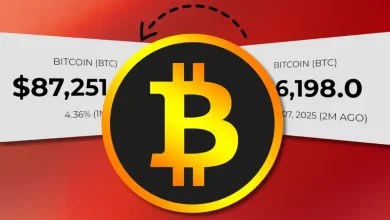Bitcoin Bull Run Builds Momentum as China, U.S., and Europe Inject Massive Liquidity
-
BTC $ 85,397.53 (-0.67%)

China injects over ¥1.1 trillion liquidity, boosting markets and positioning Bitcoin as alternative.
U.S. debt surpasses $38 trillion, with money printing risks fueling Bitcoin’s safe-haven appeal.
Bitcoin hits $125,689 with $3.2 billion ETF inflows, strengthening role as global hedge.
The global economy seems to be repeating a familiar story, one that could once again light a fire under Bitcoin. From Asia to the West, major economies are quietly preparing to inject fresh liquidity into their financial systems.
And just like in 2020–21, this could be the setup for Bitcoin and other risk assets to surge.
Global Liquidity Surge Could Fuel Bitcoin Bull Run
In October 2025, the People’s Bank of China (PBoC) announced a 1.1-trillion-yuan ($154.8 billion) outright reverse repo operation to maintain ample liquidity, following a 600-billion-yuan ($84.5 billion) injection just weeks prior.
The goal is clear: support a slowing economy, stabilize the property sector, and assist local governments facing financial strain.
With the Chinese yuan hovering near multi-year lows, global capital is increasingly seeking alternative stores of value, positioning Bitcoin as a “digital escape valve.”
“Each wave of liquidity from China tends to ripple through global risk assets,” said one market strategist. “This time, Bitcoin could be the biggest beneficiary.”
The U.S. Debt Crisis and Liquidity Crunch Point Toward a Bitcoin Hedge
Across the Pacific, the U.S. national debt is now rising by about $6 billion per day, surpassing $38 trillion this month. Political voices, including Donald Trump, are already hinting that America must “grow out of debt,” a signal that more money printing and quantitative easing (QE) could soon return.
Wall Street analysts expect the Federal Reserve to consider new stimulus measures if the Treasury’s cash balance falls below $700 billion, a move that could pull $400–500 billion from bank liquidity.
“Every time dollars flood the system, hard assets like Bitcoin strengthen,” noted a Bloomberg macro analyst.
This looming liquidity wave could once again position Bitcoin as a hedge against U.S. monetary expansion and inflation risks.
Japan and Europe Prepare for More Stimulus, Boosting Global Crypto Demand
In Japan, markets have already responded to the recent pro-stimulus political shift. On the first trading day after the election, the Nikkei 225 surged nearly 5%, reflecting investor optimism for tax cuts and fiscal spending.
Meanwhile, Europe’s economic growth remains sluggish. The European Central Bank (ECB) projects just 1.2% GDP growth in 2025, barely outpacing population growth. With inflation cooling and growth fading, the ECB has kept the door open for renewed monetary easing.
“Europe’s policy flexibility is limited, but if the slowdown deepens, liquidity injections are inevitable,” said an ECB watcher.
Together, Asia, Europe, and the U.S. appear to be aligning toward a new era of global liquidity a perfect storm for Bitcoin’s next major breakout.
Bitcoin Becomes the Safe Haven in a Global Liquidity Storm
Bitcoin has moved from the sidelines to the center of global finance. On October 6, 2025, it hit a new all-time high of $125,689, driven by $3.2 billion in weekly ETF inflows.
BlackRock’s iShares Bitcoin Trust (IBIT) now manages over $96.2 billion in assets, while Fidelity’s FBTC added another $692 million last week. Collectively, spot Bitcoin ETFs are expected to pull nearly 100,000 BTC from circulation in Q4 2025 alone.
With a market cap above $2.45 trillion and growing participation from Asia and Europe, Bitcoin is emerging as the top hedge against global liquidity risk and fiat currency debasement.
“Bitcoin is no longer a speculative asset, it’s a core component of global asset allocation,” said a senior fund manager at a major U.S. investment firm.
Why 2025 Is Different: Institutional Adoption Strengthens Bitcoin’s Position
Unlike in the previous cycle, crypto market fundamentals are far stronger today. Institutional adoption has accelerated, regulatory frameworks are clearer, and liquidity is deepening through ETFs and structured products.
U.S. regulators are even reviewing pension fund access to crypto investments, a move that could unleash billions in new institutional demand.
“We’re witnessing the mainstreaming of Bitcoin as a global macro asset,” said a Fidelity strategist.
As central banks inject liquidity and investors seek refuge from fiat depreciation, Bitcoin is positioned to be the prime beneficiary of the 2025 global monetary reset.
Many top analysts predict Bitcoin could hit $200,000 by the end of 2025—a level that may no longer seem far-fetched in the face of synchronized global stimulus.
Never Miss a Beat in the Crypto World!
Stay ahead with breaking news, expert analysis, and real-time updates on the latest trends in Bitcoin, altcoins, DeFi, NFTs, and more.
FAQs
Major economies like China, the U.S., Japan, and Europe are injecting cash to support growth, stabilize markets, and prevent economic slowdowns.
Increased liquidity often drives investors toward hard assets, making Bitcoin a key hedge against inflation and currency debasement.
Spot Bitcoin ETFs like BlackRock’s IBIT and Fidelity’s FBTC attract institutional funds, reducing circulating supply and boosting market value.
Many analysts predict Bitcoin could hit $200K due to synchronized global stimulus, institutional adoption, and growing investor demand.
Trust with CoinPedia:
CoinPedia has been delivering accurate and timely cryptocurrency and blockchain updates since 2017. All content is created by our expert panel of analysts and journalists, following strict Editorial Guidelines based on E-E-A-T (Experience, Expertise, Authoritativeness, Trustworthiness). Every article is fact-checked against reputable sources to ensure accuracy, transparency, and reliability. Our review policy guarantees unbiased evaluations when recommending exchanges, platforms, or tools. We strive to provide timely updates about everything crypto & blockchain, right from startups to industry majors.
Investment Disclaimer:
All opinions and insights shared represent the author's own views on current market conditions. Please do your own research before making investment decisions. Neither the writer nor the publication assumes responsibility for your financial choices.
Sponsored and Advertisements:
Sponsored content and affiliate links may appear on our site. Advertisements are marked clearly, and our editorial content remains entirely independent from our ad partners.








